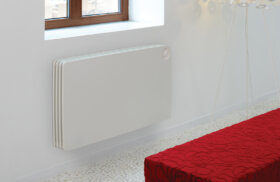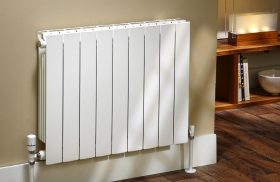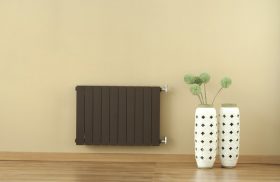Before the cold weather creeps up again, be sure to check that every part of your central heating system or radiators is working properly. This will give you a chance to organise any repair work or carry out any essential maintenance that needs to be completed so your home stays warm during the winter months.
By servicing your boiler as well as fixing, cleaning, bleeding and balancing your radiators during the summer, you won’t have the extra hassle of worrying about when the temperature starts dropping.
Service your boiler
Now is the perfect time to arrange your annual boiler service. It will ensure your boiler is in tip-top condition ready for the work it’ll need to do over the long winter months. It will also flag any issues that could potentially cause a problem when the weather is at its coldest, for example, that the thermostat is working properly, or your heating system needs flushing to clean out any accumulation of dirt and sludge in the system.
Make sure you choose an engineer who is Gas Safe registered. If you are unsure what a boiler service involves, the consumer association Which? has published a handy checklist of what your engineer should be looking at.
How to prepare radiators for winter
Assessing Radiator Functionality
First thing’s first, you need to check for any existing problems with your radiator. If you find any issues, you’ll need to have them repaired or replaced depending on the problem at hand.
It’s crucial to have your heating system checked regularly by a qualified technician or heating engineer, but there are also certain issues you can look out for:
- Check the temperature – your radiators should be heating up evenly, but if you find that one or more radiators are not heating up as well as the others, this could be a sign of a problem.
- Check for leaks – look for any signs of water or coolant leaking from the radiators.
- Check for air bubbles – air bubbles can get trapped in the radiators, which can prevent them from heating up properly. Bleeding the radiators will remove any trapped air.
- Check the valves – ensure that the valves are open and that they have not seized up. If the valves are not open, the radiators will not be able to heat up properly.
The three most common signs of a failing radiator are overheating, a lack of heating and leaking. If you feel cold patches on the bottom of your radiator while the heating is on, this tells you that the flow of water around the radiator is being restricted.
One of the most common causes of ‘cold spots’ is an obstruction such as radiator sludge. Addressing these problems through flushing the system, making necessary repairs or replacing radiators before winter comes around is key to an efficient heating system and a warm home.
Bleeding Radiators
Bleeding your radiator is how you get rid of trapped air that stops hot water circulating around your heating system effectively. This will assist with a few common issues such as ‘cold spots’ and air bubbles. So, how do you go about bleeding your radiator?
- Turn off the central heating system. This will prevent hot water from coming out of the radiator when you bleed it.
- Locate the bleed valve. Look for a small, round valve with a square hole in the centre, usually located at the top of the radiator, near the top corner.
- Get a radiator key. A radiator key is a tool that is used to turn the bleed valve. You can buy this at most hardware stores.
- Place a cloth under the bleed valve. This will catch any water that comes out of the valve when you bleed it.
- Insert the radiator key into the bleed valve. Turn the key anti-clockwise until you hear a hissing sound. This is the air escaping from the radiator.
- Continue turning the key until water comes out of the valve.
- As soon as the water appears, close the bleed valve by turning the key clockwise.
- Turn on the central heating system and check that the radiator is heating up properly.
If you don’t have a radiator key, you may be able to use a flathead screwdriver to turn the bleed valve (depending on the valve), but radiator keys are cheap and widely available.
Be careful not to bleed the valve too far, or you could cause damage to the radiator. Bleeding your radiator is essential to improving its efficiency and maintaining its good condition.
Cleaning Radiators
Keeping your radiator clean will not only lead to it looking much better, but is also key to ensure optimum performance. When your radiator is free from dust and dirt, the natural convection works efficiently.
Debris can easily accumulate between the radiator fins and this can hinder the heat output as it has to work doubly hard to heat the room – leading to higher heating bills.
Regularly cleaning your radiators will ensure they are in tip-top condition, and doing so just before winter ensures they’re performing efficiently.
Here are a few general tips on how to keep your radiators clean:
- Vacuum the fins regularly with a vacuum cleaner attachment or a brush.
- Wipe down the exterior of the radiator with a damp cloth to remove any dust or dirt that has accumulated on the outside of the radiator.
- Use a mild soap and water solution to clean the radiator. Avoid using harsh chemicals, as these can damage the radiator.
- Dry the radiator thoroughly after cleaning to prevent rust.
Balancing Radiators
To balance a radiator simply means to distribute the flow from the boil and pump throughout all the radiators in your home. Balancing radiators can be done by redirecting the heat in your radiators to flow around each radiator rather than just one and back to the boiler.
If you’ve noticed one of your radiators taking longer to heat up than another, it might need balancing. According to the Heating and Hotwater Industry Council, balancing a central heating system can improve operating efficiency, comfort and reduce energy usage.
Balancing your radiator can be done through adjusting the valves, so they all heat up at the same speed. For instance, adjusting a radiator valve that’s too hot allows more hot water to flow to the radiators that are too cold or take a while to heat up.
It’s important to note that if you also plan to bleed your radiator, the bleeding should be done before balancing. Balancing does require a few tools, but these are easy to pick up from your local hardware store.
They include the following:
- Radiator bleeding key
- Lockshield valve adjuster or adjustable spanner
- Screwdriver
- Digital thermometer or multimeter with a thermometer function
Upgrading Thermostatic Radiator Valves (TRVs)
Thermostatic Radiator Valves (TRVs) are essential for controlling the temperature of each radiator individually. These are the most common radiator valves and they usually have numbers indicating a particular setting. By using the valves for temperature control, your radiator will work as a more energy-efficient system.
As a result, you save energy from being wasted heating rooms that you’re not using or that don’t require as much heat as others. This means you’ll also save on energy bills!
Choosing the right valves for your radiator can be tricky, so check out our guide to help you decide.
Winter-ready central heating system
Summer is the best time to get your central heating ready for the winter months. Once the cold weather hits, the last thing you’ll want to do is run around trying to get your heating in order.
Take the time now to repair and replace any radiators that aren’t functioning properly so your heating system is in perfect condition to keep your home warm and cosy next winter.
Feel free to contact us for expert advice on how to maintain and repair your radiator.





